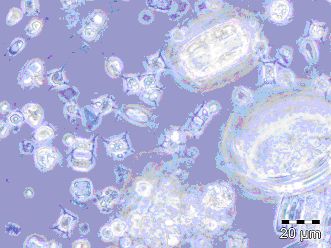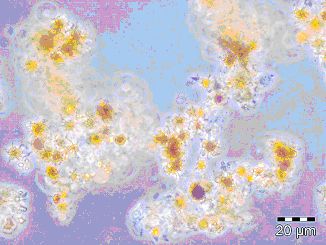Sedimentation of particulate organic matter in the central Baltic basin
|
||||
Key message
In spite of high seasonal variability in the vertical particle flux, the yearly integrated rates for sedimentation of organic matter in the Gotland Sea are amazingly similar for a period from 1995 until 2003. The major Baltic inflow event in January 2003, however, exerted a pronounced effect on both surface biomass production and mode of vertical particle transport, which in this year led to an overall increase of organic carbon supply to the sediment by a factor of four.
Background
A particular role in Baltic ecology rests upon to those particles and aggregates, whose sinking connects pelagic and benthic cycles of matter. This process forms the first step of material transfer from the pelagic food web of the surface waters to the sedimentary environment and further into geological cycles. The analysis of sinking particles and the transfer of elements to the sediment allows conclusions on the state of external nutrient loading of the Baltic ecosystem and helps to reconstruct past environmental conditons of this sea. These analyses are performed since 1995 in the central Gotland Sea (Station 271 = BMP J1), where sinking matter is continuously collected by means of large funnel-shaped devices (sediment traps, Figure 1, 2).

Fig. 1: Sediment trap array of IOW in the central Gotland Sea

Fig. 2: Vertical flux of particulate organic nitrogen into a sediment trap suspended in 180 m water depths at station BMP J1 in the central Gotland Sea. Note, that in the first 2 years some periods are missing because of initial technical failures of the instrument.
Results and assessment
Annual sedimentation dynamics in the Central Baltic can be separated into three qualitative and quantitative distinct periods, which can be allocated to different drivers of pelagic biomass production. Winter surface accumulated nutrients are used by spring bloom algae, summer mixed layer biomass production is governed by nitrogen fixing cyanobacteria and increased water mass convection in autumn finds its response in an autumn bloom of a mixed algal community. All three surface production peaks are reflected in respective transport events of organic matter to the sediment. During the last decade, the sedimentary carbon supply was dominated by summer sedimentation, which made up to 2/3 of the yearly flux (Figure 3, 4).

Fig.3: Monthly means of vertical flux of particulate organic carbon from a sediment trap suspended in 180 m water depths at station BMP J1 in the central Gotland Sea

Fig.4: Monthly means of the isotopic signature of particulate nitrogen in a sediment trap suspended in 180 m water depths at station BMP J1 in the central Gotland Sea. Low values during the sedimentation peak in summer indicate nitrogen fixation to be the major N-source.
In 2003 this typical annual pattern was visible again. However, as the basic flux of organic matter in this year exceeded the means from 1995 until 2002 by far (Figure 5) an equivalent higher input of accessible nutrients to the mixed layer has to be assumed, driving this particle export. This can be attributed to the heavy inflow of oxic bottom water into the Gotland Sea in early spring, when parts of the old, nutrient rich bottom water were mixed up into the surface mixed layer and enhanced biomass production. In terms of volume exchange, this major Baltic inflow ranks 25 in the list of the 97 inflow events since 1897.

Fig.5: Vertical flux of particulate organic carbon in a sediment trap suspended in 2003 at 180 m water depths at station BMP J1 in the central Gotland Sea. The rates in 2003 are exceeding the 8 year mean by far.
On top of the high base level of pelagic sedimentation over all seasons the rates were further enhanced by a summer maximum, which was characterized by very high mineralic proportions and high phosphorus content of the material. The source for this material could be identified as large amounts of sedimenting manganese oxide and iron phosphate minerals. They had been formed, when disolved reduced forms of manganese and iron in the bottom water were oxidized by the successive bottom water exchange in the Gotland basin. Their sedimentation resulted in an effective clearance of phosphate from the lower water column, which was chemically bound to the minerals. In further sequence, these mineralic particles can as well enhance the sinking speed of organic aggregates, which they encounter, by increasing their specific weight (Figure 6, 7). Thereby the exposition of fast sinking organic material to pelagic mineralisation is highly reduced and higher vertical transport is the result. The inflow event therefore had a pronounced direct effect on the sedimentation regime in the Central Baltic and proved to be an efficient driver particularly for phosphorus retention in the basin.

Figure 6: Microphotograph of material (mostly diatoms) from the spring sedimentation peak 2003

Fig. 7: Microphotograph of material (mostly manganese covered aggregates) from the summer sedimentation peak 2003
References
Feistel, R., Nausch, G., Matthäus, W. and Hagen, E. 2003: Temporal and spatial evolution of Baltic deep water renewal in spring 2003. - Oceanologia 45 (4), 623-642.
Neretin, L.N., Pohl, C., Jost, G., Leipe, T. and Pollehne, F. 2003: Manganese cycling in the Gotland Deep, Baltic Sea. Marine Chemistry 82,125-143
Shaffer,G. 1986: Phosphate pumps and shuttles in the Black Sea. Nature321:515-517
Struck, U., Pollehne, F., Bauerfeind, E. and v. Bodungen ,B. 2004: Sources of nitrogen for the vertical particle flux in the Gotland Sea (Baltic Proper) - results from sediment trap studies. Journal of Marine Systems 45: 91– 101
Additional information
Cruise reports, oxygen deficiency maps: http://www.io-warnemuende.de/research/en_datbild.html
Marine Science reports: http://www.io-warnemuende.de/research/mebe.html
Acknowledgments
The German part of Baltic Monitoring Programme (COMBINE) is conducted by IOW on behalf of the Bundesamt für Seeschifffahrt and Hydrographie (BSH), financed by the German Bundesministerium für Verkehr (BMV).
Summary
The major Baltic inflow of 2003 exerted a large quantitative influence on central Baltic sedimentation dynamics.
For reference purposes, please cite this indicator fact sheet as follows:
[Author’s name(s)], [Year]. [Indicator Fact Sheet title]. HELCOM Indicator Fact Sheets 2005. Online. [Date Viewed], http://www.helcom.fi/environment2/ifs/en_GB/cover/.
Last updated 25 Nov 2005.

